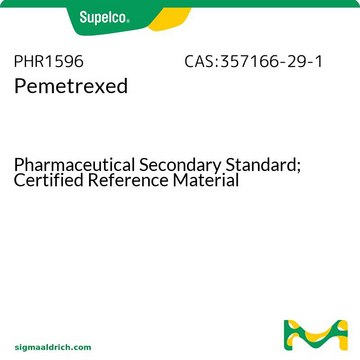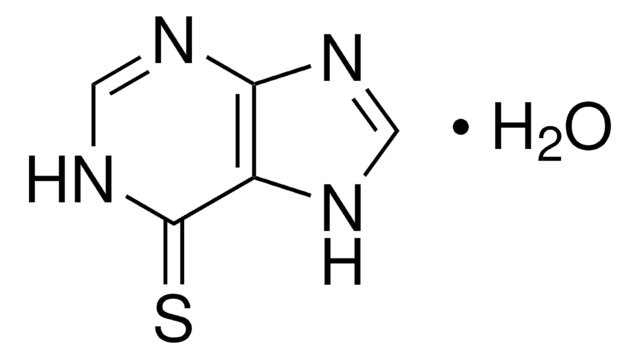PHR1624
Cisplatin
Pharmaceutical Secondary Standard; Certified Reference Material
Synonym(s):
cis-Diammineplatinum(II) dichloride, cis-Dichlorodiammine platinum(II), cis-Platinum(II) diammine dichloride, Cisplatin
About This Item
Recommended Products
grade
certified reference material
pharmaceutical secondary standard
Quality Level
Agency
traceable to Ph. Eur. C2210000
traceable to USP 1134357
API family
cisplatin
CofA
current certificate can be downloaded
packaging
pkg of 200 mg
technique(s)
HPLC: suitable
gas chromatography (GC): suitable
mp
270 °C (lit.)
application(s)
pharmaceutical (small molecule)
format
neat
storage temp.
2-30°C
SMILES string
N.N.Cl[Pt]Cl
InChI
1S/2ClH.2H3N.Pt/h2*1H;2*1H3;/q;;;;+2/p-2
InChI key
LXZZYRPGZAFOLE-UHFFFAOYSA-L
Looking for similar products? Visit Product Comparison Guide
General description
Cisplatin is an antineoplastic drug used for the treatment of cancer patients with a variety of different malignancies.
Application
Biochem/physiol Actions
Analysis Note
Other Notes
Footnote
related product
Signal Word
Danger
Hazard Statements
Precautionary Statements
Hazard Classifications
Acute Tox. 2 Oral - Carc. 1B - Eye Irrit. 2 - Resp. Sens. 1 - Skin Irrit. 2 - Skin Sens. 1 - STOT SE 3
Target Organs
Respiratory system
Storage Class Code
6.1A - Combustible acute toxic Cat. 1 and 2 / very toxic hazardous materials
WGK
WGK 3
Flash Point(F)
Not applicable
Flash Point(C)
Not applicable
Choose from one of the most recent versions:
Certificates of Analysis (COA)
Sorry, we don't have COAs for this product available online at this time.
If you need assistance, please contact Customer Support.
Already Own This Product?
Find documentation for the products that you have recently purchased in the Document Library.
Customers Also Viewed
Articles
Antineoplastic agents separated with excellent resolution.
Our team of scientists has experience in all areas of research including Life Science, Material Science, Chemical Synthesis, Chromatography, Analytical and many others.
Contact Technical Service












